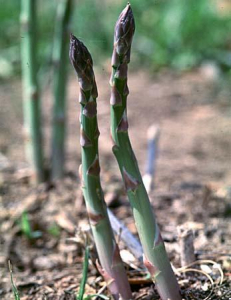Asparagus may seem like an unusual vegetable that would be difficult to grow in the garden. However, a gardener can successfully grow asparagus if they understand how an asparagus plant grows.
Asparagus is different from other vegetables in that it is a perennial which means it will grow and produce for several years without having to plant it each year. This makes asparagus a slightly different vegetable in that when you select a site for planting, you will need to choose a permanent location for the plants to live for many years. Asparagus can produce for 15 years or more is planted and managed properly.
Asparagus plants are either male or female. The female plants produce more spears but are smaller than ones from a male plant. When it comes to varieties, Mary Washington, which is rust-resistant, is common variety planted in home gardens. Mary Washington and Martha Washington varieties are a mix of male and female plants, so more will have to be planted to produce adequate yield. Other varieties include Jersey Gem and Jersey Knight, are male hybrids, meaning they produce mostly male plants thus increasing yield.
It is recommended to plant 10 crowns for each family member to have enough fresh asparagus. If your family or you really like asparagus, or you want extra to freeze, then you will want to plant around 25 plants per family member. If planting male hybrids like Jersey Gem and Jersey Knight, you can reduce the number of plants by half since they produce higher yields.
Good soil preparation is a big plus when growing asparagus. The best type of soils for asparagus is well-drained, fertile, sandy loam soils. Most soils in our area don’t have a lot of clay, but if you are in a location with clay soils then you can improve the drainage by adding peat moss or compost. Another way to improve the soil drainage would be to build a raised bed. Incorporating organic matter (compost) and tilling the soil deeply several times can create a good location for asparagus. Fertilizers, along with manures, can be beneficial in preparing the soil for planting. If the soil has not been tested, 3 to 5 lbs of 5-10-10 per 100 ft2 can be broadcasted.
In Eastern North Carolina, asparagus is planted in late January into February. Asparagus crowns (roots) are best planted in a trench that is around 8 inches deep. The trench should be wide enough to allow the root system to be fully spread out. Crowns should be placed in the trench with the buds pointed upward and cover with 2 inches of soil. As the plant grows, you will continue to gradually pull soil around the plants until the trench is full. The trench rows should be 5 feet apart with the crowns spaced 12 inches apart in a row. Closer in-row spacing will increase yield but will shorten the life of the bed.
Unfortunately, you can’t get too excited about eating asparagus the first year after planting. You do not want to harvest asparagus the first growing season after planting crowns. In the second year, you can lightly harvest for a short time (2 weeks). Harvesting too much, too early will result in weak plants and small spears. After the second year, you can harvest asparagus 6 to 8 weeks each spring. Weak plants should be harvested for less time than stronger plants. When harvesting, you will cut or snap the spears at ground level to prevent damaging spears that have not emerged yet.
Care after asparagus is established is fairly simple. You will want to keep weeds and grass under control in your asparagus bed. Each spring just before spears emerge, broadcast a fertilizer like 5-10-10 at a rate of 2 to 5 lbs per 100 ft2. This can be done around March 1st in Eastern North Carolina. A second application of fertilizer is recommended at the end of the cutting season. At the end of a growing season, let the plants grow until they turn brown and then cut down the ferns and remove from the bed. Cutting down the plant too early, before frost, will reduce next year’s spear harvest.
Asparagus can be an interesting plant to grow. It is important to remember that it is a perennial, so you will need a permanent location for it to grow and it will take a couple of years before getting to enjoy a harvest. If you like the idea of having fresh asparagus, it will be worth the wait.
Jessica Strickland is an Agriculture Extension Agent, specializing in horticulture for North Carolina Cooperative Extension in Wayne County.

(Photo Credit: plants.ces.ncsu.edu)

